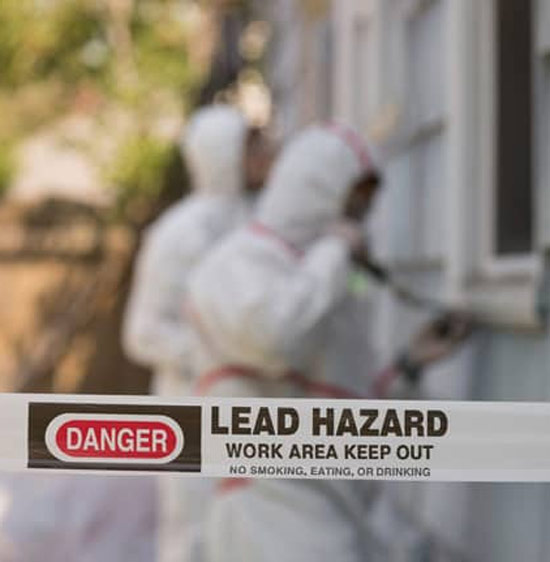Step-by-Step Process for Effective Lead Infraction Removal
Following this, adherence to government and state laws is paramount to creating an efficient remediation plan. The actual remediation needs knowledgeable workers to implement these strategies while strictly complying with safety and security protocols. What occurs after the removal is completed?

Detection and Assessment
Detection and analysis are vital actions in the removal of lead infractions. To make sure an effective remediation process, it is essential to perform an extensive examination of the environment where potential lead exposure exists.
This consists of assessing the level and intensity of contamination, as well as determining populations at risk, particularly youngsters and expectant females. The gathered data ought to be diligently recorded to sustain the growth of an effective remediation method.
Moreover, it is vital to focus on areas with the highest levels of contamination and those that pose the best wellness risks. Efficient interaction with stakeholders, consisting of homeowner, citizens, and public health authorities, is essential for guaranteeing that all celebrations are educated about the findings and the subsequent actions needed for remediation. This initial detection and analysis stage prepares for an effective lead violation removal procedure.

Lawful and Regulatory Conformity
Navigating the landscape of legal and governing compliance is a crucial facet of successful lead offense remediation. Conformity ensures not just the safety and security of affected populaces yet additionally the credibility and legal standing of the company in charge of removal. Rules governing lead contamination are multifaceted, incorporating government, state, and neighborhood legislations. At the federal level, the Environmental Protection Company (EPA) sets rigorous standards under the Toxic Compounds Control Act (TSCA) and the Lead-Based Paint Improvement, Fixing, and Painting Guideline (RRP Policy)
This entails careful documentation of all removal tasks to demonstrate compliance. Failing to stick to these guidelines can result in extreme fines, including significant penalties, legal activity, and reputational damages.
Involving lawful specialists concentrated on environmental legislation can assist in navigating these intricacies. Regular training and qualification for all employees entailed in the remediation process are also necessary to make sure adherence to safety and security and regulatory standards. By prioritizing lawful and governing compliance, companies can properly minimize risks and attain a successful remediation end result.
Planning the Removal
Efficiently planning the removal of lead offenses begins with a thorough evaluation of the infected website. This initial assessment should consist of a comprehensive website investigation to determine the degree and focus of lead contamination. Comprehensive sampling and research laboratory analysis are paramount to create an exact contamination account. This data-driven technique guarantees that remediation efforts are suitably targeted and efficient.
When the contamination is mapped, a risk assessment must be performed to evaluate possible health and wellness threats to human beings and the setting. Lead Violation Removal in NYC. This analysis ought to take into consideration aspects such as exposure pathways, populace vulnerability, and environmental impacts. The insights collected will form the basis for picking an ideal remediation approach
Subsequently, establishing clear, achievable purposes for the removal project is important. These objectives ought to line up with regulatory standards and stakeholder expectations to ensure conformity and neighborhood acceptance. Establishing a comprehensive removal strategy that lays out techniques, official source timelines, and source allotment will certainly promote a structured strategy to the clean-up process.
Moreover, it is important to involve with stakeholders early and preserve transparent communication throughout the preparation phase. This consists of educating regional communities, acquiring necessary authorizations, and coordinating with regulative agencies to make certain all legal and procedural demands are satisfied. A well-crafted removal strategy not just resolves the contamination properly however likewise develops count on and participation among all events involved.
Carrying Out the Removal
With a well-structured remediation plan in location, the focus changes to the actual execution of the remediation tasks. This phase includes mobilizing the necessary resources, including experienced personnel, customized tools, and premium materials. Begin by clearly defining roles and responsibilities to ensure responsibility and smooth control among employee.
This includes establishing up containment areas to avoid lead dust and particles from spreading, as well as employing air filtration systems to maintain air high quality. Use methods such as damp scraping, chemical stripping, or encapsulation, depending on the seriousness and location of the contamination.
Throughout the remediation procedure, conduct regular assessments and air quality monitoring to ensure conformity with regulatory criteria. Reliable communication with stakeholders, consisting of residential property proprietors and owners, is vital to keep them informed of progression and any type of unexpected developments. By carefully adhering to these steps, the remediation tasks can be performed effectively and successfully, eventually mitigating lead threats.
Post-Remediation Techniques
Post-remediation strategies play a crucial function in making sure the long-term success of lead infraction remediation initiatives. These techniques include ongoing tracking, upkeep, and community education to prevent future lead direct exposure and guarantee a safe atmosphere.
First, regular surveillance is vital. This involves routine testing of the formerly influenced areas to make sure that lead degrees continue to be within secure restrictions. Homeowner should establish a routine for these examinations, preferably in partnership with certified great site ecological professionals.

Third, educating the neighborhood plays a crucial function in sustaining the advantages of removal. Citizens and property managers ought to be educated about the dangers of lead exposure and the very best practices for maintaining a lead-safe setting. Workshops, educational pamphlets, and neighborhood conferences can be effective devices for disseminating this info.
Conclusion
Effective lead violation removal calls for a thorough, systematic method incorporating discovery and assessment of contamination, adherence to lawful and regulatory requirements, precise preparation, and efficient execution of removal efforts. This methodical process emphasizes the significance of thoroughness and watchfulness in addressing and alleviating lead contamination.